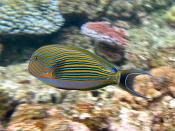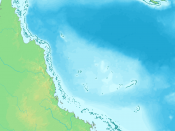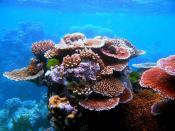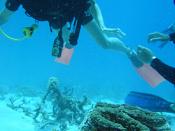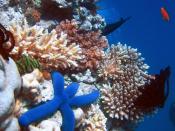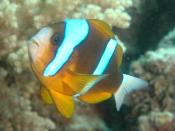-Outline 2 physical characteristics of the Great Barrier ReefThe Great Barrier Reef is the world's largest coral reef system. It is located on the northeast coast of Queensland next to the Pacific Ocean. The reef extends from the Torres Straight Islands to Sandy Cape near Fraser Island. Nearly 3,000 individual coral reefs and some 300 small coral islands form the reef, which ranks as the world's largest structure made by living organisms .The reef is approximately 37,000 square kilometers, accounting for 13% of the world's total coral reefs. In 1975, The Great Barrier Reef Marine Park and The Great Barrier Reef Marine Park Authority were established. The purpose of this was to conserve this area for the benefit of present and future generations by balancing conservation and human use. The actual park covers 344,800 square kilometers by covering the waters surrounding the reef. The reef's outer edge ranges from as close as 30 km to the Australian mainland, to as far as 250 km .
The Great Barrier Reef supports around 350 species of stony coral and 1,500 species of fish, some of which are sharks. The stony corals that build coral reefs are slow-growing but long-lived corals. Many types of stony corals grow in the Great Barrier Reef, including branching corals, stag horn corals, massive corals, brain corals, plate corals, and mushroom corals .Coral reefs are the most ideal place for marine life to live. The large surface of the coral reef provides natural shelter and food. It is because of this that coral reefs are the homes of the largest ecosystems in the world. Some fish that inhabit The Great Barrier Reef include Damselfish, Wrasse, Butterfly fish, Angelfish, Cardinal Fish, Groupers and Basslets.
Discuss the Human Environment and the Human Interactions that occur in the Great Barrier ReefThe coastal zone along the Great Barrier Reef contains the majority of marine tourism infrastructure, ports and harbours, urban and resort development and industrial development .
UrbanStretching from Bamaga to Gladstone, there are more than 10 towns along the length of the Great Barrier Reef. This is also known as the coastal zone. Approximately 25% of the land area of Queensland is part of a network of 26 major river catchments that drain directly into the Great Barrier Reef marine Park. Run-off from the urban development is one of the largest impacts affecting the water quality of the Great Barrier Reef . There is extra stress on the Great Barrier Reef Marine Authority's ability to conserve the Great Barrier Reef as population growth rises in urban centres along the coastal zone. Increased growth often leads to increased demand for marine tourism, and recreational infrastructures such as marinas, ferry terminals, safe harbours and jetties .
IndustryThe largest industry surrounding the Great Barrier Reef is fishing. The fishing industry in the Great Barrier Reef, controlled by the Queensland Government, is worth 1 billion Australian dollars annually . There are many reasons why people fish in the Great Barrier Reef. Commercial fishing and recreational fishing are the biggest reason, however, some may fish as a traditional means to support one's family. The fishing industry of Great Barrier Reef employs around 2000 people.
AgricultureToday 80% of the land adjacent to the Great Barrier Reef World Heritage Area supports agricultural production, primarily beef cattle grazing and intensive cropping agriculture . Approximately 4,500,000 cattle graze in the Great Barrier Reef Catchment, which is the largest single land use. The grazing has caused widespread soil erosion which empties out into the Great Barrier Reef World Heritage Area.
The most common crop grown in the Great Barrier Reef Catchment is the sugarcane. Along with the soil erosion, fertilizers and pesticides that are originally intended for the sugar cane are washed down rivers, estuaries and eventually the Great Barrier Reef World Heritage area.
TourismEvery year, the Great Barrier Reef attracts more than 1.6 million tourists from all over the globe. These tourists may snorkel around the Great Barrier Reef, enjoy a cruise or just enjoy the beaches. No matter what they do, tourists bring with them rubbish and distractions from the life the normal life of fish living in the Great Barrier Reef. Rubbish is usually left lying around and when rain comes, the rubbish is swept down the drain and into the sewers, which then empty out into the sea. This rubbish can pollute the water and can be potentially fatal to fish. For example, a plastic bag can wrap it self around a fish's head or get lodged inside a sharks throat. The fish will eventually die of suffocation or starvation. Distractions to the normal life of fish come in the form of the multitude of cruises provided for the tourists. These cruises usually follow the same route every day and eventually it may scare away all the fish from the area. This also affects the ecosystem. Distractions can also be the snorkeling tourists. At the beginning of the day, most tourism operators scatter food for fish around the areas where they bring tourists to snorkel to keep business running. Eventually, these fish may become dependent on this food and will stop eating their natural prey. These prey will multiply and also mess up the ecosystem.
Continual construction of hotels for tourists on islands and resorts destroy the habitats of some birds use to live in that area. This affects the ecosystem of the Great Barrier Reef because when the birds are totally driven away from the Great Barrier Reef, the fish that were once prey to the birds now multiply. An increase in this kind of fish may result in the extinction of a different species of fish as a result of the increase of demand on food.
AboriginalThe Great Barrier Reef has long been known to and utilized by the Aboriginal Australian and Torres Strait Islanders peoples . The Great Barrier Reef has been home to aboriginal Australians for more than 40,000 years and the Torres Strait islanders have lived there for more than 10,000 year ago. The Great Barrier Reef is also an important part of culture and spirituality in the 70 or so groups of Aboriginals or Torres Strait Islanders.
Outline the Aboriginal Heritage that exists within the Great Barrier ReefThe Great Barrier Reef has been home to the Australian Aboriginals and Torres Strait islanders long before the first settlers arrived. More than 42,000 Torres Strait Islanders/ Australian Aborigines live in the coastal cities of Townsville and Cairns. Cape York Peninsula extends about 800km north of Cairns. It has a population of 15,000, half of which are Australian Aboriginals and Torres Strait Islanders.
The Australian Aboriginals that live near the Great Barrier Reef have burial grounds. These burial grounds are of high cultural and heritage significance to the Indigenous Australian peoples. The old burial grounds and sites have slowly disappeared under rising sea levels. Erosion along the coast and islands has exposed some burial sites and remains, and traditional owners have conducted some traditional reburials on islands within the Great Barrier Reef.
There are many specific traditional lifestyles that are important to the indigenous cultural heritage of Australia in the Great Barrier Reef Marine Park area. Some include:â¢Seek food for nourishment on a daily basis and for special occasions or ceremoniesâ¢Seek natural products including plant material for the production of baskets, necklaces and other goods12â¢Implement, control and monitor traditional management measures to maintain biodiversity in the sea and the on the land12â¢Develop and use knowledge systems including Traditional Ecological Knowledge, for daily interaction with the sea country12Totems are physical representations of an animal that is adopted as the family or clan emblem. Some groups can be identified by their totems, which can be all kinds of animals. They are an important part of cultural identity and are especially significant in song, dance or names on cultural implements.
Include 2 recent media reports dealing with an Environmental issue in the Great Barrier ReefMedia report 1Students join effort to protect the Reef11 February 2008Rasmussen State School will join thousands of students along the Queensland coastline in pledging their commitment to the Great Barrier Reef, when they officially become a Reef Guardian School this Tuesday. Great Barrier Reef Marine Park Authority Reef Guardian Schools Coordinator Ms Megan Sperring said it was the students idea to join the programme. "It is really exciting to see the students driving their involvement in the programme with teachers working to follow their lead. "Because of the enthusiasm with which Rasmussen State School is becoming a Reef Guardian, we are expecting great things from them this year. The school already has big plans for its first year as a Reef Guardian. Located more than 15 km from the ocean, the school's focus will be on improving wetlands and sharing the message that the activities we do away from the coast can still impact the Great Barrier Reef. Rasmussen students will be mentored by Central State School during their first Wetlands Unit, which was designed in collaboration with the Queensland Wetlands Programme. Student Charli Jones said she was excited to become a Reef Guardian and was looking forward to getting her feet wet in the school's Wetlands Unit. "Our school decided we should become a Reef Guardian school because this term we are learning about wetlands and trying to protect the Reef. "We want the whole school to help look after the Reef so it doesn't die." Student Ally Watkins agreed that protecting the Great Barrier Reef was an important job for schools. "We decided we should become a Reef Guardian School because the Reef is getting destroyed. "If we become Reef Guardians the Reef could last longer. "It will last longer because if we all learn about the Reef, we will tell others all about it and then they will want to help protect the Reef too." Rasmussen State School Principal Loretta Swayn said she is thrilled that her school is joining the programme. "Becoming a Reef Guardian School is a very practical way that we can look after our local environment. "Our Values Education program focuses on Sustainability in the 21st Century, so we are already committed to environmental protection at Rasmussen. "Our young people are very excited about playing a part in preserving the Great Barrier Reef for their future."Healthy wetlands boost fish stocksThursday 31 January 2008The Great Barrier Reef Marine Park Authority (GBRMPA) and the Burdekin Shire under the Reef Guardian Council program are urging the community to consider the importance of wetlands to the local environment and the health of the Great Barrier Reef.
GBRMPA Chairman Mr Russell Reichelt said that over the last 150 years many wetlands have been lost due to coastal development and agricultural growth.
"Wetlands play a vital role in filtering out nutrients and sediments before that water reaches the Great Barrier Reef lagoon," he said.
"Water Quality is a critical issue for the Great Barrier Reef and if we are to have a Reef that is resilient in the face of climate change then healthy wetlands are pivotal."Burdekin Shire Council Mayor, Cr Lyn McLaughlin said as just one of four Reef Guardian Councils in Queensland the Council took its responsibility to look after wetlands seriously.
"Wetlands play a vital role in our Shire in filtering out some pollutants while also providing a nursery ground for important fish stocks," Cr McLaughlin said.
"The Shire is undertaking a project of re-establishing passage for native fish at Horseshoe Lagoon which will result in improved fish stocks in downstream estuarine areas such as Barramundi Creek.
"On World Wetlands Day this Saturday I encourage everyone to consider the important role wetlands play in our community and in helping to protect the Great Barrier Reef," Cr McLaughlin said.
Project funding of $65 000 was received to help undertake this project through the Commonwealth Recreational Fishing Grants.
The wetlandsWetlands are vital to the Great Barrier Reef. They protect our shores from wave action, reduce the impacts of floods, absorb pollutants and provide habitats for plants and animals. The wetlands also provide shelter and an area to develop for young marine life and because of this, Australia's recreational and commercial fishing industries rely on this area. The purification of water also starts in the wetlands. This is the most vital use of the wetlands surrounding the Great Barrier Reef. The water quality of the Great Barrier Reef starts at the wetlands. Wetlands play a vital role in filtering out nutrients and sediments before that water reaches the Great Barrier Reef lagoon . If the quality of water is poor as it enters the Great Barrier Reef, many fish, whose bodies are unaccustomed to this polluted , may die.
Infilling and drainage pipes that lead to the wetlands have caused significant degradation of the wetlands. More than 50% of the wetlands have been affected by the growing agriculture and resource consumption required in that area. Also, a significant amount of modern development has begun in the areas around wetlands. The increase in pollution added to the noise of development may eventually drive most animals away from their natural habitats in the wetlands. This will have impact greatly on the ecosystem of the wetlands and ultimately the ecosystem of the Great Barrier Reef.
The involvement of students and teachers in the conservation of the Great Barrier Reef has helped in many ways. As well as promoting the idea of community involvement in the conservation of the Great Barrier Reef, the Rasmussen State School will also contribute to preserving the wetlands and advertise the fact that even though people may not live near the reef, their actions may still affect it. $65 000 has been given to aid in the conservation of the wetlands. This donation was given by the Commonwealth Recreational Fishing Grants, who realized that the more higher the quality if water, the more amount of fish there were to be fished. Also, the local shire, Burdekin Shire, has undertaken a project to re-establish a passage near Horseshoe lagoon in an attempt to increase the number of fish in areas down-stream like Barramundi creek.
The Great Barrier Reef Marine Authority Reef Guardian Schools programme is about supporting schools whose aim is to help conserve the Great Barrier Reef and reduce their consumption of the natural resources so that the rate of regeneration for resources is greater than the actual consumption of the resources (Ecological Footprint). The programme is successful as each year, more schools from the Queensland region join their cause.
BibiographyIntroduction "Great Barrier Reef," Microsoftî Encartaî Online Encyclopedia2007 http://encarta.msn.com é 1997-2007 Microsoft Corporation. All Rights Reserved.
Formation and physical features "Great Barrier Reef," Microsoftî Encartaî Online Encyclopedia 2007 http://encarta.msn.com é 1997-2007 Microsoft Corporation. All Rights Reserved.
Formation of the Reef "Great Barrier Reef," Microsoftî Encartaî Online Encyclopedia2007 http://encarta.msn.com é 1997-2007 Microsoft Corporation. All Rights Reserved.
Coastal Development, GRMPA, http://www,grmpa.gov.au/corp_site/key_issues/water_quality/coastal_developmentGreat Barrier Reef, Wikipedia, http://en.wikipedia.org/wiki/Great_Barrier_Reef#FishingAgriculture, GRMPA http://www,grmpa.gov.au/corp_site/key_issues/water_quality/agricultureIndigenous Heritage in the Great Barrier Reef World Heritage Area, Burial grounds, http://www.grmpa.gov.au/onboard/home.marine_park/what_makes_the_reef_special/indigenous_heritage_in_the_great_barrier_reef_world_heritage_areaIndigenous Heritage in the Great Barrier Reef World Heritage Area, Traditional cultural lifestyles, http://www.grmpa.gov.au/onboard/home.marine_park/what_makes_the_reef_special/indigenous_heritage_in_the_great_barrier_reef_world_heritage_areaIndigenous Heritage in the Great Barrier Reef World Heritage Area, totems, http://www.grmpa.gov.au/onboard/home.marine_park/what_makes_the_reef_special/indigenous_heritage_in_the_great_barrier_reef_world_heritage_areaStudents join effort to protect reef, GRMPA , http://www.gbrmpa.gov.au/corp_site/info_services/media/media_archive/2008/students_join_effort_to_protect_the_reefWetlands GRMPA http://www.grmps.gov.au/corp_site/info_services/media/media_archive/2008/healthy_wetlands_boost_fish_stocks
